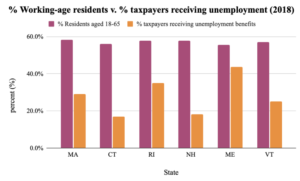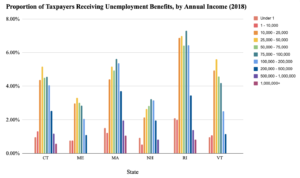Unemployment Claims in New England: Who receives the most in unemployment benefits?
Unemployment is a hot topic only exacerbated by the COVID-19 pandemic. Perusing the Pioneer Institute’s MA IRS DataDiscovery database reveals many interesting trends about unemployment benefits in New England.
In 2018, MA gave out over $1.11 billion in unemployment benefits, more than double the amount given in CT, the state with the second-highest dollar amount of unemployment. Benefits given in RI, ME, VT and NH are also a small percentage of the benefits given in CT.

This is unsurprising, given MA, CT and RI have the highest maximum weekly benefit in New England.
Benefits are calculated similarly across all the six states: wages are averaged over a base period, which is usually two to three of the quarters in which the most was earned out of the past five quarters. That figure is divided by the number of weeks benefits would be received, which is usually somewhere between 22 and 26. However, all six states that make up New England have different maximum weekly benefits.
As of 2021, MA and CT again come out on top with their max weekly benefit, capping unemployment payments at $823 and $698 respectively. This makes sense considering their relatively higher costs of living.
Because of this, it is also unsurprising that MA and CT have some of the highest portion of their taxpayers claiming unemployment benefits, 35% and 29%, respectively in 2018. While there may be other factors contributing to the high unemployment claims in these states, the high maximum weekly benefits certainly play a role.
 However, it’s striking that RI actually has the highest portion of its taxpayers claiming unemployment benefits: 43%. RI sits behind MA and CT for total given in unemployment and max weekly benefit, but still has about 10% more of its taxpayers receiving unemployment. This is also odd considering the percentage of working-age residents (ages 18-65) in RI is not that much different than the rest of New England.
However, it’s striking that RI actually has the highest portion of its taxpayers claiming unemployment benefits: 43%. RI sits behind MA and CT for total given in unemployment and max weekly benefit, but still has about 10% more of its taxpayers receiving unemployment. This is also odd considering the percentage of working-age residents (ages 18-65) in RI is not that much different than the rest of New England.
One final thing to note is that the distribution of unemployment benefits by income bracket for all New England states appears bell-shaped, meaning those in the middle class generally receive more in unemployment benefits than those in the lower or upper classes. This makes sense, since benefits are calculated based on pre-layoff income, which will be higher for those in middle income than lower income.

It will be interesting to see how unemployment trends change once 2020 and 2021 data becomes available.
Isabel Wagner is a Roger Perry Government Transparency Intern at the Pioneer Institute. She is currently studying Political Science and Economics at Boston College.



